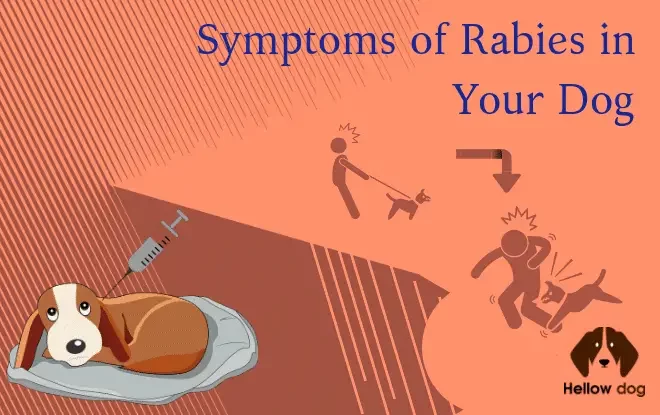Rabies is a condition when the gray matter in the brain of a dog is affected by a fatal viral called polio encephalitis and dysfunctions in the central nervous system. Rabies has always been a scary name for the pet-owners! Among the known infectious diseases in dogs, rabies is perhaps the oldest. The nervous system of dogs gets adversely affected when infected by this fatal viral disease. Also, Rabies is a highly contagious disease that might spread to any animal or even human beings. In case your pet dog hasn’t been appropriately vaccinated against Rabies, there is a high chance that it might suffer from this disease multiple times in its lifetime. When you notice the following symptoms, you may be able to say it as rabies in dog symptoms. As such you should get proper medical assistance immediately.
Signs to Look for Early Rabies Symptoms
There are some preliminary symptoms that last during the early two to ten days of Rabies. If you find any of such symptoms in your dog, search for any bite mark that might be present in your dog’s body.
Some of such signs include-
- Fever
- Chills
- Vomiting
- Diarrhea
- Irritability
- Pain in the muscles
- Uneasy movement
- Cough, etc
If you find out any of these, go to a vet soon.
Check Out for Symptoms at a Later Stage
The chronic symptoms of Rabies include a few more drastic symptoms. It lasts for three to seven days. This form of rabies is known as dumb or paralytic rabies. Your dog might foam around the mouth and finally become paralyzed. Also, it will act in a lethargic way and remain confused. The dumb form symptoms of rabies include: Paralysis, The lower jaw gets dropped off, A strange barking sound, unlike a normal one, Excessive foaming and difficulty in swallowing – unusual shyness or aggression, Constant irritability, etc.

Check Out the Aggressive Signs in Dogs
This is the furious form of rabies which lasts for again three to seven days. Excessive aggressiveness is seen in your dog. At this stage, you should take some significant preventive steps to take care of the fact the dog is not biting you. Otherwise, you might suffer from dreary health hazards. Some of the symptoms at this stage include:
- Hydrophobia which is nothing but the fear of water.
- It might look like that the dog is going to bite you and then unconsciously show all its teeth.
- Abnormal behaviors like chewing its own legs or sometimes on rock and rubbish.
- It might try to bite you your hand when you show your hand.
- When you get to see such signs, you should understand that its high time you take your dog to the vet.
Check Out for an Open Wound in the Dog
If an infected animal bites an uninfected one, it is the saliva which transmits the disease. The virus can easily get carried to a healthy dog’s body through such a wound. So, if you find any such wound in your dog’s body, it is a clear indication that your canine friend is suffering from rabies. In such a scenario, you should take your dog to the vet immediately.
Identify if There is a Choking Sound
If you see that there is an abnormal choking sound in your dog, it is quite prevalent that rabies is being identified. You need to see a doctor soon. Well, choking might not signify rabies always. It could be the signal that your dog has engulfed something hard and huge.
So, firstly, you need to open its mouth with both of your hands and see whether you can manage to remove that. Howbeit, if you don’t find any obstruction, but your dog simply chokes, rabies might be the scene. You need an immediate vet’s attention then.
This is how you need to understand whether your pet dog is suffering from rabies or not. If you find even a single symptom in your dog from the ones mentioned above, get your dog proper medication now.
Prevention of Rabies
Prevention is the main issue if Rabies has to be eliminated. It is in fact simple. Fortunately, it is also quite simple. The most important thing is routine vaccination for dogs and pets. Dogs should be vaccinated once a year. A vet should be consulted as per the prevailing laws in the concerned states.
According to the CDC, 40,000 pet-owners, a year are receiving a permanent prevention treatment for rabies.
For the prevention, the doctor gives two shots Rabies immune globulin for initial protection and then apply the Rabies vaccine four times for better protection, on the first day, the third day, the seventh day and the fourteenth day. In some severe conditions, another shot is given on the twenty-eighth day.

Some Rabies-Related Facts
Certain vaccines can treat rabies, and it is prevalent in about 150 countries.
Rabies in dogs are mostly responsible for human deaths. Dogs transmit about 99% of the Rabies.
International organizations such as WHO, (OIE), the (FAO) and (GARC) have set up a global front to fight against rabies unitedly and to eliminate death through rabies by 2030 totally.
Every dog must be vaccinated against the rabies virus as per law in the USA.
Forty thousand pet-owners a year are receiving a permanent prevention treatment for rabies according to CDC.
Rabies Laws
Most states in the USA have laws requiring rabies vaccinations for both dogs and cats, including quarantine for animals infected by Rabies.
Conclusion
We can conclude by saying that only animals with rabies virus can transmit it to any other man or animal when they are bitten. It is easily assumed that there is no reason for panic as long as we can avoid rabies with precaution. If at all affected, a vet should be consulted to enhance chances of being a fatal one. To avoid any untoward situation, any to avert serious risk the only option is to go for vaccination. Last but not least, don’t forget to VACCINATE your dog!
Disclaimer Note:
All information contained in this website is intended for informational purposes only, as I am not a veterinarian. Furthermore, the content of the website should not be understood as an appeal to ignore the instructions or advice that may be issued by your veterinary doctor.
We express our gratitude for sharing information and thank the authors for using certain parts as reference:
https://www.who.int/news-room/fact-sheets/detail/rabies
https://www.petmd.com/dog/conditions/neurological/c_multi_rabies#







